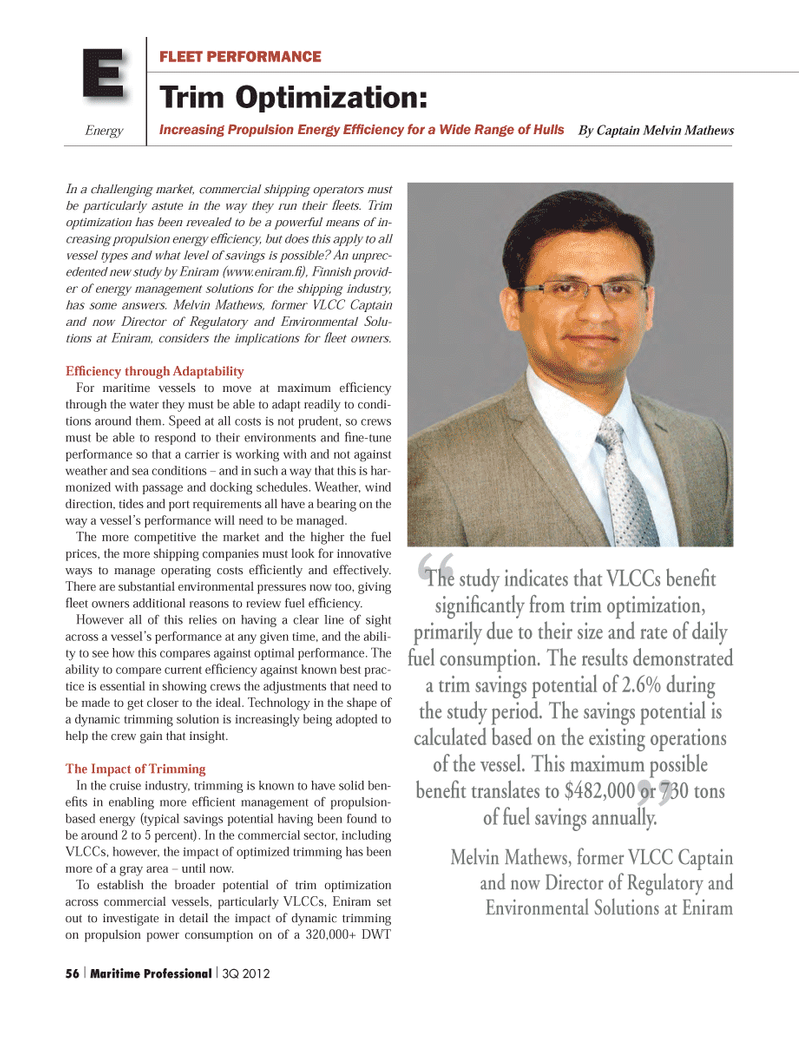
Page 56: of Maritime Logistics Professional Magazine (Q3 2012)
Classification Societies, Quality & Design
Read this page in Pdf, Flash or Html5 edition of Q3 2012 Maritime Logistics Professional Magazine
In a challenging market, commercial shipping operators must be particularly astute in the way they run their ß eets. Trim optimization has been revealed to be a powerful means of in- creasing propulsion energy efÞ ciency, but does this apply to all vessel types and what level of savings is possible? An unprec- edented new study by Eniram (www.eniram.Þ ), Finnish provid- er of energy management solutions for the shipping industry, has some answers. Melvin Mathews, former VLCC Captain and now Director of Regulatory and Environmental Solu- tions at Eniram, considers the implications for ß eet owners. EfÞ ciency through Adaptability For maritime vessels to move at maximum efÞ ciency through the water they must be able to adapt readily to condi- tions around them. Speed at all costs is not prudent, so crews must be able to respond to their environments and Þ ne-tune performance so that a carrier is working with and not against weather and sea conditions Ð and in such a way that this is har- monized with passage and docking schedules. Weather, wind direction, tides and port requirements all have a bearing on the way a vesselÕs performance will need to be managed. The more competitive the market and the higher the fuel prices, the more shipping companies must look for innovative ways to manage operating costs efÞ ciently and effectively. There are substantial environmental pressures now too, giving ß eet owners additional reasons to review fuel efÞ ciency. However all of this relies on having a clear line of sight across a vesselÕs performance at any given time, and the abili- ty to see how this compares against optimal performance. The ability to compare current efÞ ciency against known best prac- tice is essential in showing crews the adjustments that need to be made to get closer to the ideal. Technology in the shape of a dynamic trimming solution is increasingly being adopted to help the crew gain that insight. The Impact of Trimming In the cruise industry, trimming is known to have solid ben- eÞ ts in enabling more efÞ cient management of propulsion- based energy (typical savings potential having been found to be around 2 to 5 percent). In the commercial sector, including VLCCs, however, the impact of optimized trimming has been more of a gray area Ð until now. To establish the broader potential of trim optimization across commercial vessels, particularly VLCCs, Eniram set out to investigate in detail the impact of dynamic trimming on propulsion power consumption on of a 320,000+ DWT Energy FLEET PERFORMANCE Trim Optimization: Increasing Propulsion Energy EfÞ ciency for a Wide Range of Hulls EBy Captain Melvin Mathews??The study indicates that VLCCs beneÞ t signiÞ cantly from trim optimization, primarily due to their size and rate of daily fuel consumption. The results demonstrated a trim savings potential of 2.6% during the study period. The savings potential is calculated based on the existing operations of the vessel. This maximum possible beneÞ t translates to $482,000 or 730 tons of fuel savings annually. Melvin Mathews, former VLCC Captain and now Director of Regulatory and Environmental Solutions at Eniram 56 | Maritime Professional | 3Q 2012MP #3 50-64.indd 56MP #3 50-64.indd 568/15/2012 1:08:38 PM8/15/2012 1:08:38 PM

 55
55

 57
57
